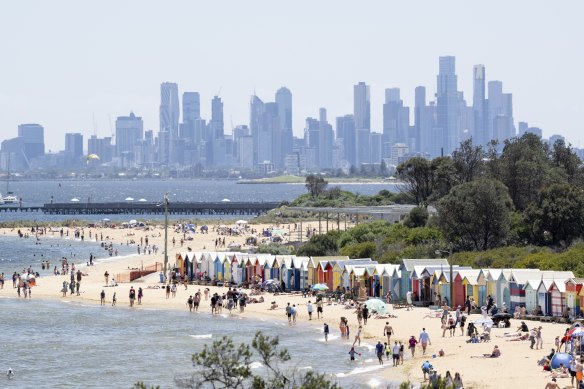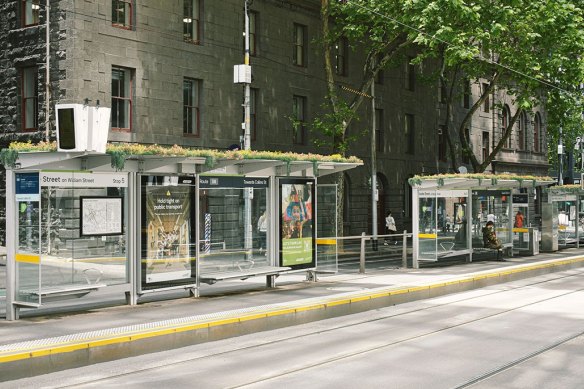Save articles for later
Add articles to your saved list and come back to them any time.
Melbourne councils are urgently planting thousands of trees, trialling awnings over street seating and could open libraries as heat refuges, as they forecast future sweltering summers that have climate campaigners calling on landlords to be legally required to cool rental homes.
On Friday, the United Nations confirmed July will be the globe’s hottest month ever recorded, amid frightening heatwaves across the northern hemisphere. Campaigners and experts say the prediction should be a warning to authorities in Melbourne of what the southern summer will bring as a likely El Nino weather pattern begins to take hold.
Melbourne councils need to prepare communities for the coming summer of heat.Credit: Penny Stephens
“It’s sobering,” says Krista Milne, one of the City of Melbourne’s heat officers, of the UN’s proclamation. “But we’ve known this day was coming.
“As we’ve seen in the northern hemisphere, [heat] actually kills more people than all other natural disasters combined. And that’s both globally and locally.”
Milne said the City of Melbourne currently experiences around 11 days of extreme heat (over 35 degrees during the day and overnight lows of at least 20 degrees), but that number was expected to rise to an average of 16 days annually by 2050.
Despite it being the middle of winter, Milne and colleague Tiffany Crawford are busily preparing for the coming summer in the CBD.
The council has committed to planting 3000 trees per year across the municipality to cool the largely concreted city, and this summer it will use awnings to cover street seating that can’t be shaded by trees.
A trial for “greening” four tram stop roofs with grasses and wildflowers had been delayed but will begin in September, and the city is considering opening more air-conditioned spaces (in addition to libraries) on extreme heat days for people who don’t have air-conditioning at home, or when heatwaves cut power in apartment buildings.
On extreme heat days, council staff will hand out to residents and visitors kits containing bottles of water, electrolytes and maps of where to find shade and water sources.
The City of Melbourne is among several councils across Australia that have trialled or implemented new heat-mitigating tools including covering roads in a sunscreen-like paint to lower temperatures, installing permeable footpaths to divert water away from storm drains and into soil for trees, and to ensure urban heat is considered as part of planning approvals.
The City of Melbourne and Yarra Trams are “greening” four tram stops in September.Credit: City of Melbourne
In Merri-bek, in Melbourne’s inner north, the council already extends opening hours for its public pools on days of extreme heat and welcomes residents to loiter in its air-conditioned libraries and community centres.
Over the next year Merri-bek plans to plant 3000 trees – and target high urban heat islands such as car parks – and has allocated $50,000 for more drinking taps along its shopping strips. The council also offers $2000 grants for low-income homeowners to insulate their homes and $3000 for solar panel installations.
But some of the more disadvantaged councils have a long way to go. For example, the City of Melton, north-west of Melbourne, has the lowest tree canopy in the metropolitan area with only 4.1 per cent coverage. The average across the metropolitan Melbourne area is 16.2 per cent.
A Melton spokesman said the council was seeking state government funding for a massive planting blitz over the next three years to increase canopy cover to over 30 per cent by 2050.
Brimbank, another of the councils worst affected by “heat island” impacts, increased its tree canopy coverage from 6.2 per cent in 2016 to 10.2 per cent by last year. It is aiming to reach 30 per cent by 2046.
Brimbank was also one of Melbourne’s first municipalities to have defined requirements for tree planting single-lot developments requiring two medium trees in front yards and a small tree in backyards.
But Emma Bacon, the founder of climate justice group Sweltering Cities, said despite the efforts of councils, the responsibility sat with state and federal governments for heat mitigation projects such as updating housing standards and allocating resources to large-scale greening.
“We need more green cover in cities, we need to make sure everything we are building is safe for the future, and we need to prepare health system effectively,” Bacon said.
Sweltering Cities recently submitted to the Victorian government’s inquiry into the rental crisis, and called for cooling to be included in the minimum standards for rentals, similar to the inclusion of heating into landlord rules for rentals in 2021.
“People across Victoria are already getting sick in the heat each summer. They’re worrying about whether they can afford to run the air-con or even just a fan,” Bacon said.
She said simple changes such as classifying an air-conditioner fix as an urgent repair would also make a huge difference to heat-distressed renters.
“I’ve spoken to renters who have even offered to pay more for their landlord to install an air-con but have been refused, so they just drive around to avoid baking hot homes,” she said.
A spokeswoman for the Victorian government said it continually monitors “minimum standards to ensure they’re meeting the needs of renters”.
The Morning Edition newsletter is our guide to the day’s most important and interesting stories, analysis and insights. Sign up here.
Most Viewed in National
From our partners
Source: Read Full Article


